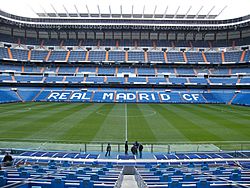Santiago Bernabéu Stadium facts for kids

|
|
| Location | Av. de Concha Espina 1, 28036 Madrid, Spain |
|---|---|
| Coordinates | 40°27′11″N 3°41′18″W / 40.45306°N 3.68835°W |
| Owner | Real Madrid C.F. |
| Operator | Real Madrid |
| Executive suites | 245 |
| Capacity | 81,044 |
| Field size | 105 m × 68 m (344 ft × 223 ft) |
| Surface | Mixto Hybrid Grass Technology |
| Construction | |
| Opened | 14 December 1947 |
| Renovated | 1982, 2001 |
| Expanded | 1953, 1992, 1994, 2011 |
| Construction cost | 288,342,653 Ptas (€1,732,943) |
| Architect | Manuel Muñoz Monasterio Luis Alemany Soler Antonio Lamela (Expansion) |
| Tenants | |
| Real Madrid | |
The Santiago Bernabéu Stadium is a football stadium in Madrid, Spain. With a current seating capacity of 81,044, it has been the home stadium of Real Madrid since its completion in 1947. It is the 2nd-largest stadium in Spain and the largest in the Community of Madrid.
The Santiago Bernabéu is one of the world's most famous football venues. It has hosted the final of the European Cup/UEFA Champions League on four occasions: in 1957, 1969, 1980, 2010. The final matches for the 1964 European Nations' Cup and the 1982 FIFA World Cup, were also held at the Bernabéu, making it the first stadium in Europe to host both a UEFA Euro final and a FIFA World Cup final.
History
In the early parts of the 20th century, Real Madrid first played at Campo De O’Donnell. The team moved to the larger Campo de Chamartín in 1924.
Santiago Bernabéu Stadium was built at the same site of Campo de Chamartín. Construction began in 1945. On the 14th of December 1947 the stadium officially opened. The first match was against Portuguese champions C.F. Os Belenenses (3-1). The stadium was initially called Nuevo Estadio Chamartin. It received the name of the club-president eight years later.
At that time, Estadio Santiago Bernabéu consisted of two uncovered tiers that could hold just over 75,000 spectators. Capacity was further increased to 125,000 in 1954, when one of the long sides got expanded with a third tier. The Bernabéu was together with Camp Nou playing venue of the UEFA Euro 1964 Championships, hosting one of the two semi-finals and the final between Spain and the Soviet Union (2-1).
Towards the end of the 1970s, the stadium had already started to age. Club officials started making plans to build a new stadium in the north of the city.
However, with the perspective of the 1982 World Cup it was instead decided to renovate the Bernabéu. The renovation included the construction of a roof over the three two-tiered stands and the installation of seats in half of the stadium. As a result, capacity was reduced to 90,800 places. During the 1986 FIFA World Cup, Estadio Santiago Bernabéu hosted three matches in the second group stage and the final between Italy and West Germany (3-1).
In the 1990s, UEFA required the stadium to become an all-seater, which would have reduced capacity to 50,000 seats. Club president Ramón Mendoza therefore started an extensive redevelopment program. The changes included extending the third tier over the entire stadium, the creation of corporate facilities, and four access towers in each corner of the stadium. Works started in 1992 and were completed two years later.
Estadio Santiago Bernabéu was further refurbished and upgraded between 2001 and 2006. Works most of all focused on improving corporate facilities. Construction was concluded in 2006 with the construction of a roof over the one remaining uncovered stand.
Additional improvements, such as a retractable roof, were delayed due to financial reasons. In 2013 club president Florentino Pérez announced Real was seeking to sell the naming rights for its stadium. A €525 million renovation project was set to begin in summer 2017, but was delayed to 2019. The capacity will remain at 81,000 seats, but the height will be increased by ten metres and a roof will be added. The club is expected to sell the naming rights to the renovated stadium.
The work is expected to last three and a half years (2019-2023).
Images for kids
See also
 In Spanish: Estadio Santiago Bernabéu para niños
In Spanish: Estadio Santiago Bernabéu para niños










